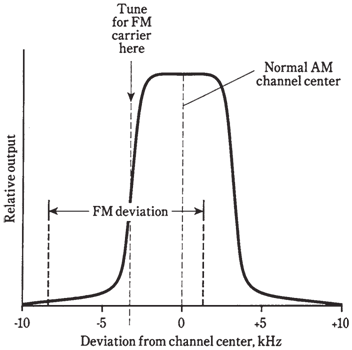Detection of FM signals
Phase-modulated or Frequency-modulated signals can be detected in many ways. The best FM receivers respond to frequency or phase changes, but not to the amplitude changes.
Slope detection
An AM receiver is used to detect FM. This can be done by setting receiver near, but not exactly on, FM signal.
An AM receiver has a narrowband filter having a passband of around 6 kHz. This gives a selectivity curve like that shown in the figure given below. If FM carrier frequency is near skirt, or slope, of filter response, modulation will cause signal to move in and out of passband. This will make receiver output vary with modulating data.As this takes advantage of the filter slope, it is called as slope detection. It has 2 disadvantages. First, receiver will respond to amplitude variations. Second, there won’t be any nonlinearity in received signal, generating distortion, as the slope is not a straight line.

Figure--Slope detection lets an AM receiver demodulate FM